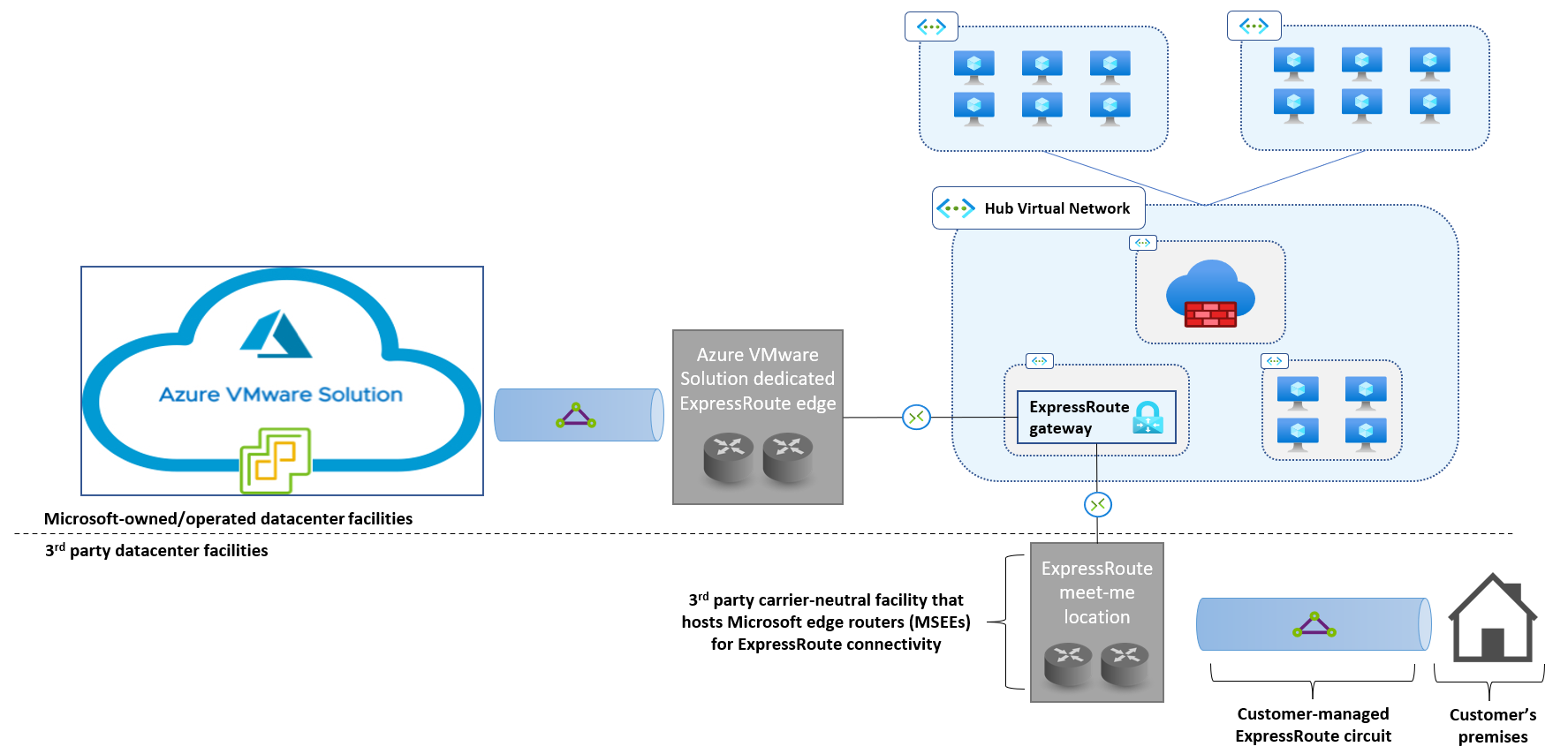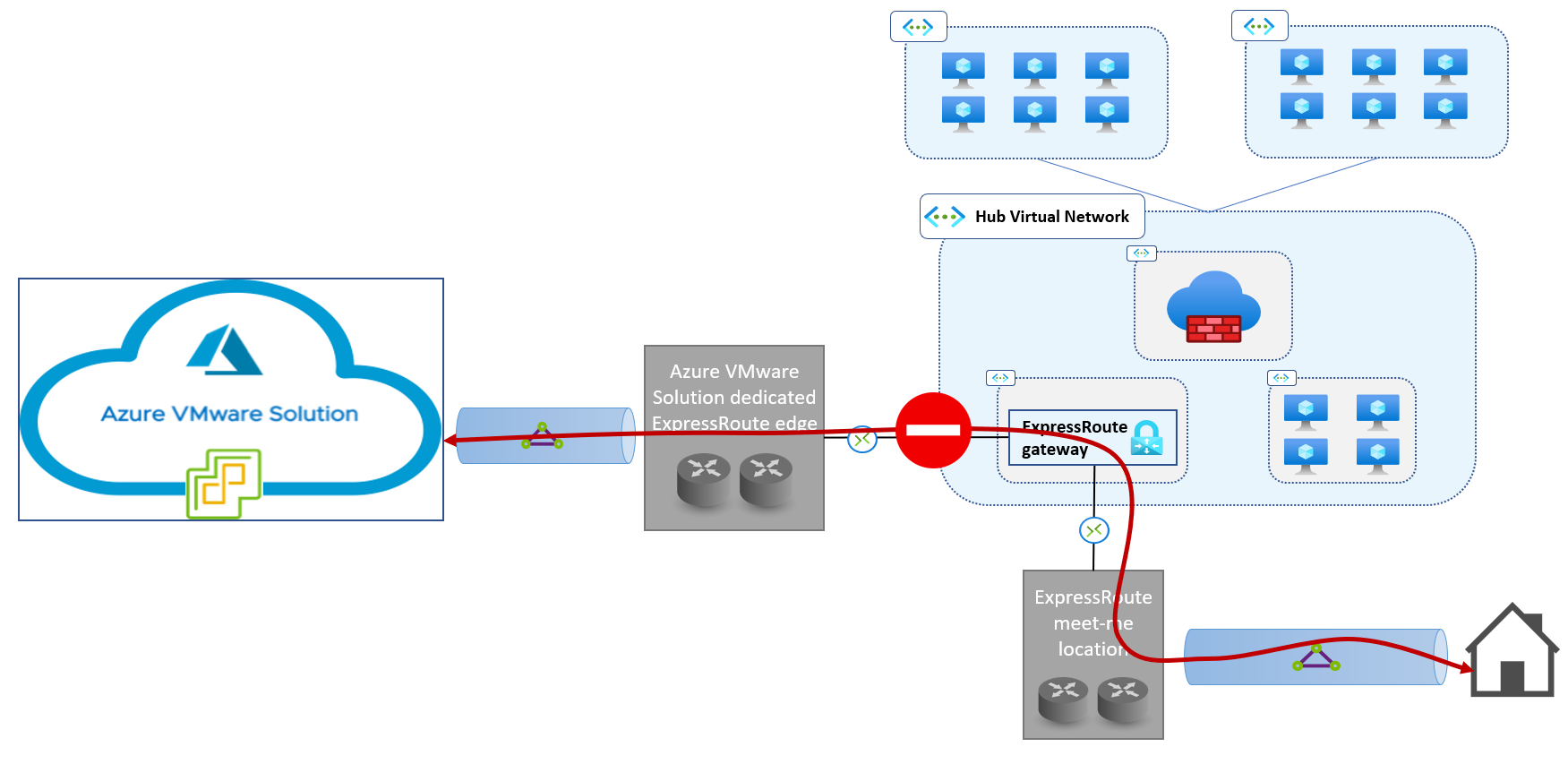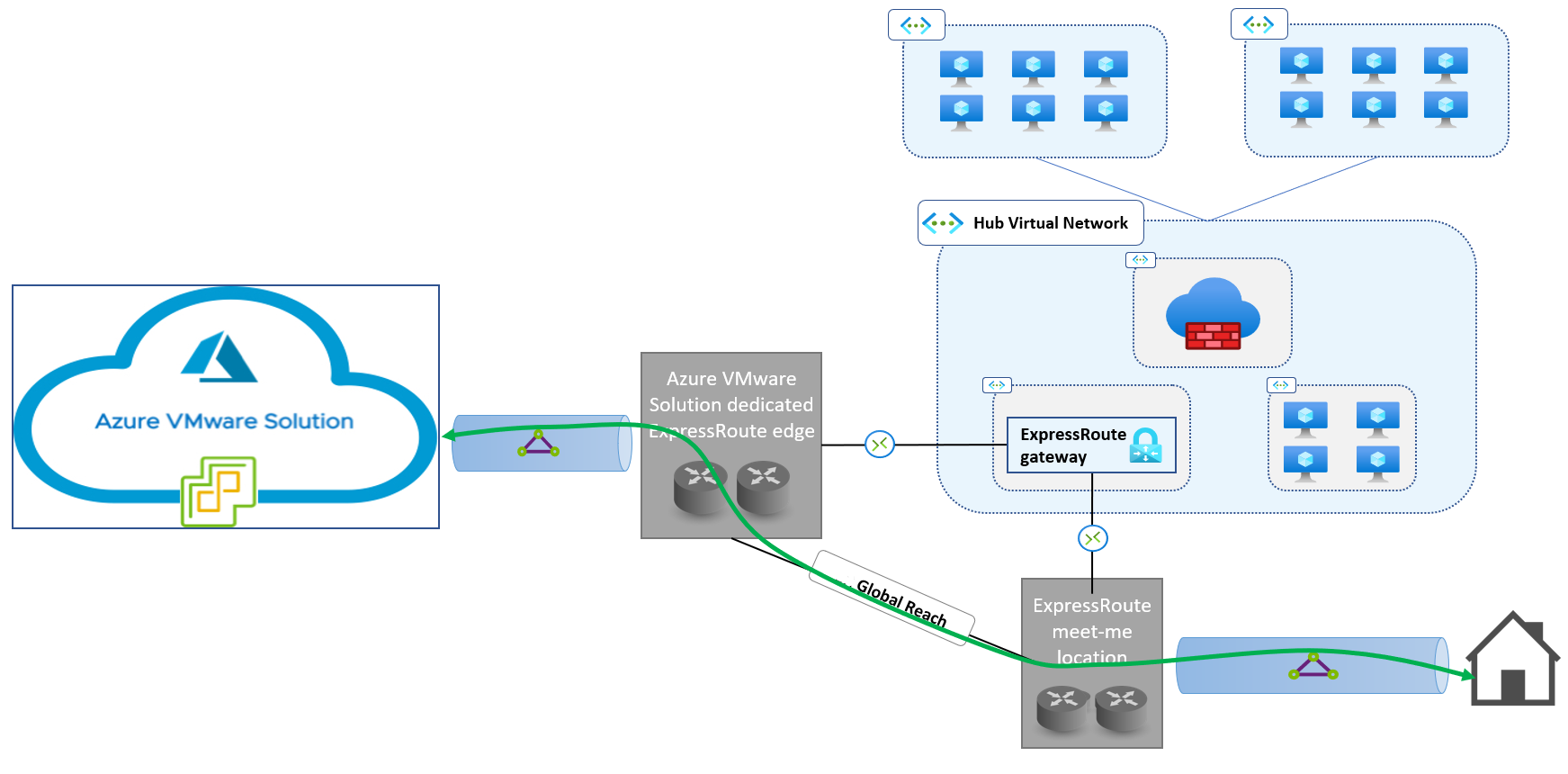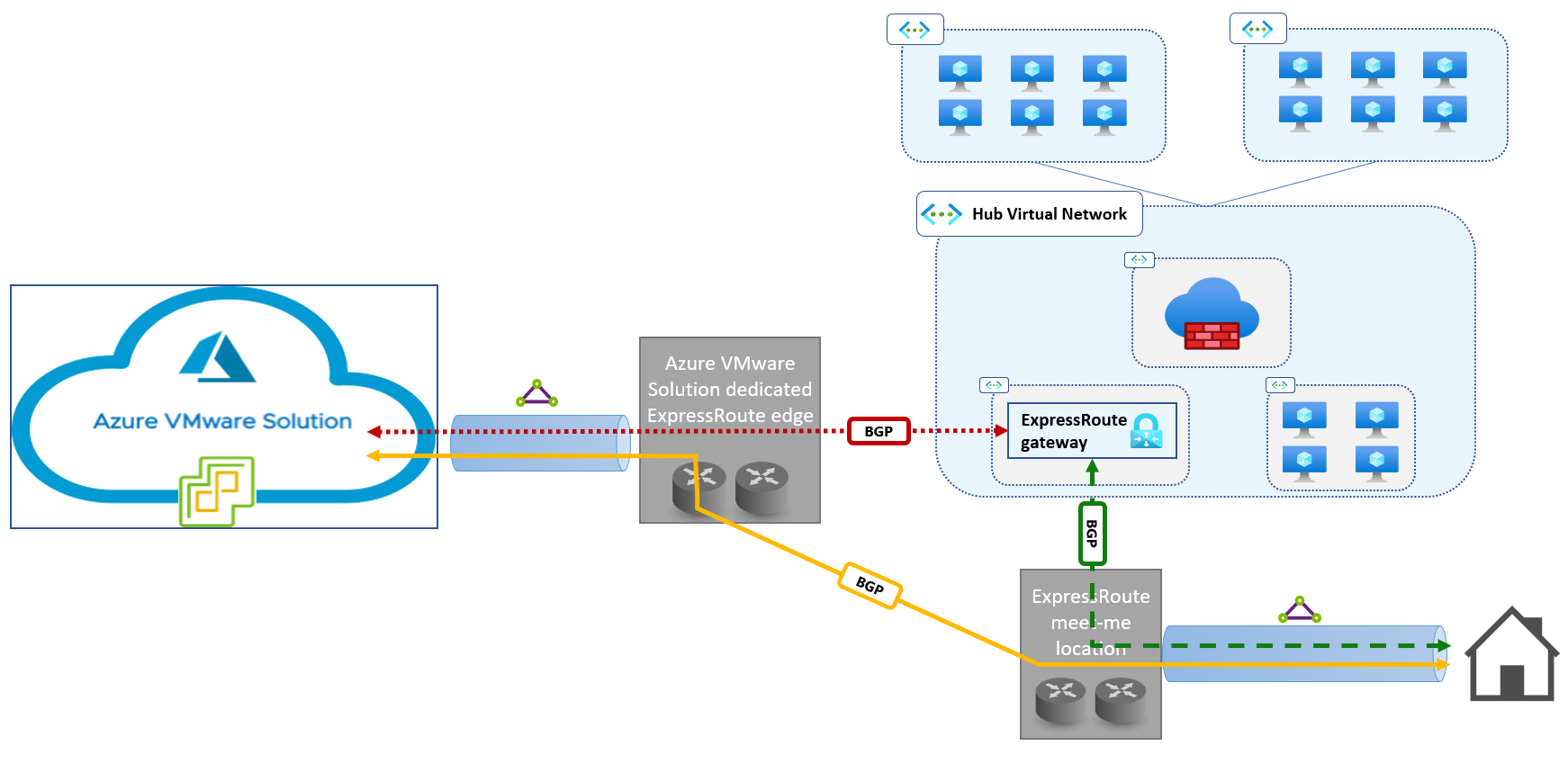Azure VMware Solution networking basics
This article summarizes some fundamental concepts about Azure VMware Solution networking. Understanding these concepts is a prerequisite to understanding the network architectures in the other articles in this guide.
Azure ExpressRoute circuits and Azure VMware Solution private clouds
Azure VMware Solution runs on bare-metal VMware ESXi nodes that are deployed in an Azure datacenter and attached to its physical network. In the same way that ExpressRoute circuits enable you to establish Layer 3 connectivity between external networks and Azure virtual networks, a dedicated ExpressRoute implementation provides Layer 3 connectivity between physical ESXi nodes and Azure virtual networks.
When an Azure VMware Solution private cloud is provisioned, an associated ExpressRoute circuit is also instantiated in a Microsoft-managed subscription. The private cloud's owner can then connect the circuit to one or more ExpressRoute virtual network gateways in Azure virtual networks by redeeming authorization keys for the circuit. (This procedure is the same as the one that's used to create connections between ExpressRoute gateways and customer-managed circuits.) See the Azure VMware Solution documentation for detailed instructions.
ExpressRoute Global Reach and Azure VMware Solution private clouds
An Azure ExpressRoute gateway can't be used to route traffic between on-premises locations that are connected to it over different circuits. This limitation also applies to the Azure VMware Solution dedicated ExpressRoute implementation, as shown here:
Global Reach is an ExpressRoute feature that enables you to connect two ExpressRoute circuits so that the networks connected to each circuit can route traffic to each other over the Microsoft backbone. Global Reach is available in the Azure VMware Solution dedicated ExpressRoute implementation. So you can use Global Reach to connect ExpressRoute circuits that are managed by Azure VMware Solution to circuits that you manage, which provides Layer 3 connectivity between on-premises networks and Azure VMware Solution private clouds.
Note
For maximum resiliency, two customer-managed ExpressRoute circuits in different peering locations should be used to connect on-premises datacenters to the Microsoft backbone. In this case, each customer-managed ExpressRoute circuit should have a Global Reach connection to the Azure VMware Solution private cloud (and to Azure Virtual Networks). Review this article for guidance on resilient ExpressRoute implementations.
Azure VMware Solution network topology
An Azure VMware Solution private cloud infrastructure includes several network segments. The segments are implemented by VMware's network virtualization stack (distributed virtual switches) and connected to the underlying physical infrastructure through the ESXi hosts' physical NICs.
Management networks support basic vSphere cluster functions, like vCenter Server and NSX-T management virtual machines, vMotion, replication, and vSAN. The management networks' address space is allocated from the /22 address block that's assigned to each Azure VMware Solution private cloud during provisioning. See Routing and subnet considerations for details on how IP address ranges from the /22 block are assigned to management networks.
Workload segments are customer-defined NSX-T segments to which Azure VMware Solution virtual machines attach. The address range for a workload segment is customer-defined. It can't overlap with:
- The Azure VMware Solution private cloud's /22 management block.
- Address ranges used in peered Azure virtual networks.
- Address ranges used in remote networks that are connected to the private cloud.
Workload segments can be attached to tier-1 gateways. An Azure VMware Solution private cloud can have one or more tier-1 gateways. You can link tier-1 gateways to the private cloud's default tier-0 gateway, which provides connectivity to the physical network outside the vSphere/NSX-T cluster.
The network topology of an Azure VMware Solution private cloud is shown here:
Dynamic routing in Azure VMware Solution
Azure VMware Solution private clouds connect to Azure virtual networks and remote sites over the managed ExpressRoute circuit. Border Gateway Protocol (BGP) is used for dynamic route exchange, as shown here:
In the standard topology shown in the preceding figure:
Routes for management and workload segments in the Azure VMware Solution private cloud are announced to all ExpressRoute gateways that are connected to the private cloud's managed circuit. In the opposite direction, ExpressRoute gateways announce routes for:
- The prefixes that comprise the address space of their own virtual network.
- The prefixes that comprise the address space of all directly peered virtual networks, if peering is configured to allow gateway transit (the red dotted line in the diagram).
Routes for management and workload segments in the Azure VMware Solution private cloud are announced to all ExpressRoute circuits connected to the private cloud's managed circuit via Global Reach. In the opposite direction, all routes announced from the on-premises site over the customer-managed ExpressRoute circuit are propagated to the Azure VMware Solution private cloud (the solid yellow line in the diagram).
The routes announced from the on-premises site over the customer-managed ExpressRoute circuit are learned by all ExpressRoute gateways that are connected to the circuit. The routes are injected into:
- The route table of the gateway's virtual network.
- The route table of all directly peered virtual networks, if peering is configured to allow gateway transit.
In the opposite direction, ExpressRoute gateways announce routes for:
- The prefixes that comprise the address space of their own virtual network.
- The prefixes that comprise the address space of all directly peered virtual networks, if peering is configured to allow gateway transit (the green dashed line in the diagram).
Note
ExpressRoute gateways don't propagate routes across circuit connections. In the preceding diagram, the ExpressRoute gateway doesn't propagate routes learned in the BGP session represented by the red dotted line to the BGP session represented by the green dashed line, or vice versa. That's why Global Reach is needed to enable connectivity between the Azure VMware Solution private cloud and the on-premises site.
Outbound data transfer charges
A managed ExpressRoute circuit that's associated with an Azure VMware Solution private cloud is instantiated in a Microsoft-owned subscription. Your subscriptions aren't billed for any costs (monthly fees or data transfer fees) that are associated with the managed circuit. More specifically, your subscriptions aren't billed for:
- ExpressRoute monthly fees for the managed circuit.
- Traffic transferred from an Azure virtual network to the private cloud over the managed circuit.
- ExpressRoute Global Reach ingress and egress traffic charges. When an ExpressRoute circuit that you own is connected via Global Reach to an Azure VMware Solution managed circuit, Global Reach ingress and egress charges are suppressed on your circuit too, if your circuit is in the same geopolitical region as the private cloud.
The ExpressRoute virtual network gateway that's connected to the private cloud's managed circuit is instantiated in a virtual network that you own, so it's billed at the standard ExpressRoute virtual network gateway rates.
Any other network-related resources, like Azure VPN gateways, Azure route servers, virtual network peerings, and public IP addresses, that are required by the topologies discussed in this guide must be deployed in your subscription. They're billed at standard rates.
For more information about billing for Azure VMware Solution, see the Common questions article.
Next steps
Learn about connectivity between Azure VMware Solution and on-premises sites.




